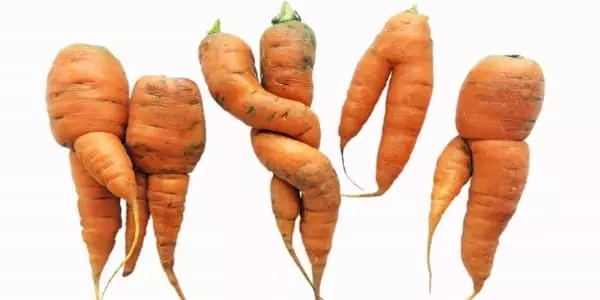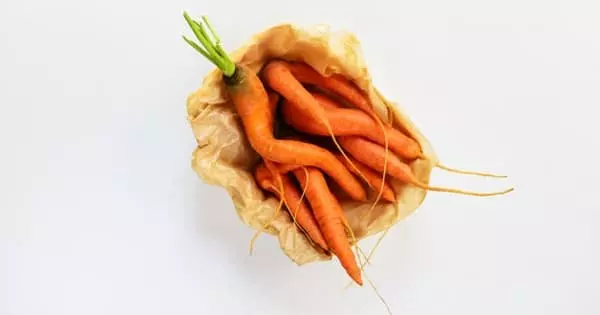According to new research, explaining the value of misshapen vegetables – that they are just as healthy as their picture-perfect counterparts and that buying them helps reduce food waste – could help boost sales of “ugly” produce.
The study assessed consumers’ reactions to hypothetical carrot shopping scenarios. After hearing both marketing messages promoting the personal and societal benefits of ugly carrots, participants were most likely to purchase bunches containing imperfect carrots. Either message alone was insufficient to persuade consumers to purchase mismatched carrots.
Findings also revealed that respondents were willing to pay, with a small discount, for some level of mixed bunches containing both ugly and standard carrots, with a maximum of 40% of misshapen carrots – a sign to regulators who set the cosmetic tolerance level that such a practice could be profitable.
According to a 2018 study conducted in North Carolina, approximately 41 percent of unharvested food is edible but unmarketable due to its appearance. The researchers are evaluating ways to “win” with ugly foods in the marketplace by testing consumer acceptance of imperfect foods that do not come with a built-in discount – a tactic used by some brick-and-mortar and online retailers that haven’t lasted long.
We see that once you promote it as more natural and as reducing wasted food, the discount is less than it would otherwise be, but there is also a cluster of folks who are actually willing to pay as much or more because they value reducing food waste and the fact that it has just as much nutrition as standard produce.
Professor Brian Roe
“Anytime you codify that cosmetically imperfect produce is somehow lesser, you’re stuck selling it for less, and thus you undermine the entire value chain,” said senior study author Brian Roe, professor in The Ohio State University’s Department of Agricultural, Environmental, and Development Economics.
“We see that once you promote it as more natural and as reducing wasted food, the discount is less than it would otherwise be, but there is also a cluster of folks who are actually willing to pay as much or more because they value reducing food waste and the fact that it has just as much nutrition as standard produce.”
Roe collaborated on the study with Louisiana State University’s Danyi Qi and Jerrod Penn, as well as Ran Li, an Ohio State PhD student. The study is available ahead of print in the Journal of Retailing and Consumer Services.

The researchers polled 1,300 Americans who shopped and cooked for their families. Participants in the online survey were randomly assigned to receive one of two marketing messages: ugly carrots have the same nutritional quality as blemish-free produce, and there are social costs associated with throwing away food with cosmetic flaws.
Participants could also choose from images of their preferred 2-pound carrot bunches and price points, with six bunches containing 0 percent to 100 percent ugly carrots and prices ranging from $2.18 to $1.39 per pound. In another choice test, consumers could choose between a bunch of all standard carrots or a bunch of all imperfect carrots with or without green leaves attached in a hypothetical purchase from a farmers market or a conventional grocery store.
Participants consistently disliked bunches that included any number of imperfect carrots, and the amount they were willing to pay for any number of imperfect carrots was always less than what they would pay for 100 percent standard carrots.
The analysis of participant responses revealed a top contender in terms of profitability for farmers: bunches containing 40% ugly carrots and 60% standard carrots with green leaves attached sold at farmers markets where consumers are exposed to the combined marketing messages.
“When you go to a farmers market, you’re thinking more holistically; you’re not concerned with cosmetic perfection. You anticipate that things will be more ‘real.” Roe stated. “So I think people realize this is what we might expect if we buy produce directly from a farmer — there’s more room for imperfection because it’s probably not perceived as such. It’s taken to mean “naturalness.”
The research team examined the consumer willingness to pay tipping point that could make harvesting ugly carrots profitable – an important calculation for farmers who need a positive return on their investment in planting, picking, and shipping their crops. The United States Department of Agriculture also has a say in the percentage of non-standard produce that can be sent to market, a limit that Roe believes should be revisited.
“We hope that these findings will change the industry’s perspective. If you want to enter the ugly produce space, you should probably rebrand it rather than locking in a discount and saying, ‘This is ugly food that should be worth less, so let’s just lock it in as an inferior good from the start,’ “he stated. “There hasn’t been a lot of rethinking of standards in light of food waste, so that would be one policy lever that could be re-examined to deal with food waste in the modern era.”





